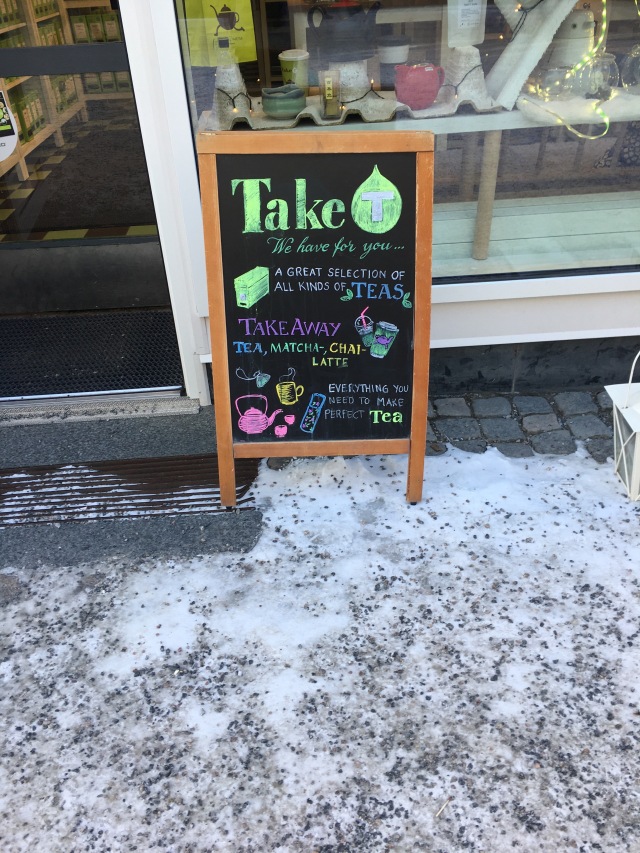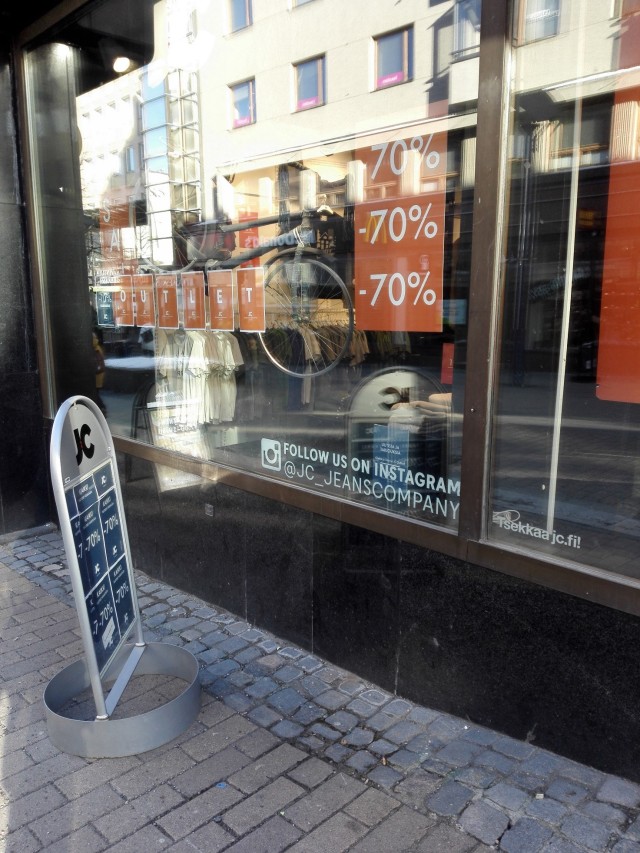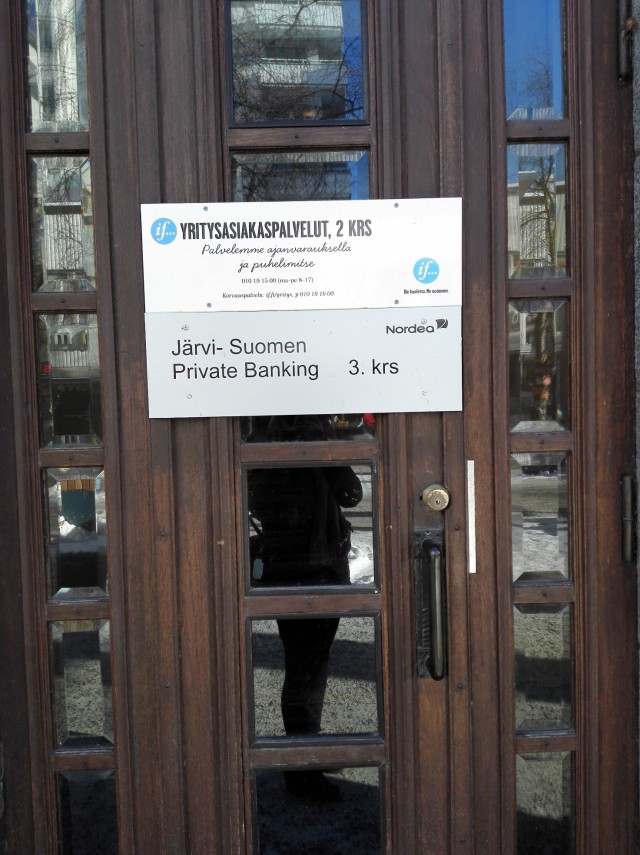By: Katarina Heikkinen & Laura Hotakainen
We set out to study the linguistic landscape, moreover, how English is used in storefront advertising in the Jyväskylä city centre instead of the native language of Finnish or Swedish. After few discussions we decided to only concentrate on the shops, and their display windows and other storefront displays, located on kauppakatu, more precisely, from kompassi to the intersection between kauppakatu and kilpisenkatu. We had previously discussed about studying the linguistic landscape around the block, consisting of Forum and the other conjoined buildings, but we felt the amount of study matter to be too much. Both of us then photographed one side of the pedestrian street of kauppakatu, and out of all these photographs we selected four that we feel represent the use of English the best.
But before we get to study and discuss about our findings, there is one question that should be answered: What is a linguistic landscape and what is it good for? A linguistic landscape, as viewed in this situation, is the manifestation, or presence and use, of different languages in a geographical area (Gorter 2006), or in our case a cityscape albeit a small portion of such. When talking more precisely about the subject and what can be counted to be parts of a linguistic landscape, Landry and Bourhis (1997:25) have summed it up perfectly:
The language of public road signs, advertising billboards, street names, place names, commercial shop signs, and public signs on government buildings combines to form the linguistic landscape of a given territory, region, or urban agglomeration.
By using this definition, we focused on, mostly, the advertising of different shops on their windows or small displays out front. Why have they chosen English as their main language of advertising, or why they have chosen to code-mix between Finnish and English? Could it be that, in jyväskylä’s case, because of the amount of foreign exchange students they are aiming to cater to larger number of customers? One might argue that this is the case as English has gained its status as a lingua franca, that many will turn to it when advertising themselves or their services and goods. This happens in advertising be it tv commercials or simple a store front.
English is mostly used in Finnish advertising to appear to be cooler or sound new and innovative, more sophisticated or to sound more scientific and technical; and in this way sound more appealing to consumers. Sometimes a Finnish translation might sound clunkier, or just simply be too long of a word or a sentence. There is also the factor that most of the businesses that are regularly using English in their advertising are mostly, but not entirely, global companies. To some of these companies translating their adverts into Finnish might be seen as waste of money, and it is also assumed that most Finns have some level of knowledge of English. It is almost a given.
When considering the factor mentioned at the beginning of the previous paragraph, translating their advertisement into Finnish might be viewed be downgrading their brand. The appeal might be lost to the consumer. There is also the fact that in some industries, such as the gaming industry, translating their advertisements into Finnish are unheard of and it usually doesn’t even cross their minds from producer to consumer alike. The games themselves aren’t translated into Finnish, so why should the advertisement be in Finnish? In this case, we could say that English has become their norm, the language to be used in any type of advertising.
Picture analysis

This sign was infront of the coffee shop Arnolds near Forum on Kauppakatu, here in Jyväskylä. Because of the location of the sign, the main purpose was to advertise the baked goods, of this coffee shop to people who were out shopping near or in the same building as this coffee shop.
This sign was interesting because the most eye-catching element in this sign is the English phrase “Why not now?”. At first, this indicated that the main audience was English speakers. But because the rest of the text that is written in the sign is in Finnish, I do not think that the main audience was native English speakers, but all people who understand English in general. This was interesting because even though the biggest audience to any brand or company in Finland would be Finnish speakers, in this case the information that was given in Finnish did not seem to be the main focus.
The goal for this type of advertisement, where the most eye- catching element is in English, could be to attract foreigners and non- Finnish speakers. People who designed the advertisement probably assumed that most Finnish people understand English either very well or at least enough to understand simple sentences, like the one used in the advertisement. This way one is able to reach a bigger audience which would include the Finnish audience and also non-Finnish speakers. Another point that I found important to point out was that the coffee shop was inside a building and could not be seen from the outside. Because of this, the advertisement could have been placed to show the right direction to the coffee shop and not to advertise the actual products. Maybe the main purpose was to just guide people to the right direction and to make sure that the people walking past were aware that there was a place to sit and have a cup of coffee nearby.

This sign was also on Kauppakatu, in front of a tea shop. Unlike the previous sign that was analysed, this was written completely in English and no Finnish words were used. Next to this sign there was similar one, which had some Finnish writing on it, but I chose this one because I found it more interesting.
Unlike the sign before, I believe that for this the main audience was English speakers. On the shop windows there were also some English signs or posters, which gave an impression that the shops main goal was to be foreigner friendly an attract non- Finnish speakers. As I was looking at this tea shop, I thought that it was a very English centred, which could indicate that maybe the owner was not a native Finnish speaker. I could be mistaken but based on the observations that were made of the sign and the fact that English was the main language of all the advertisements I saw near the shop and on the shops windows, the shop seemed to present itself as foreigner friendly.
I though this was interesting, because in Finland the main audience would in most places be Finnish speakers, but the shop chose to take this approach even though the people who designed the advertisements could have used Finnish to avoid any kind of miscommunications with Finnish people who might not understand English. Maybe this way the shop owners tried to show that they are a non-Finnish store, so when people came in they would not be surprised if they had to use a little bit of English to read facts about the products or use English in order to buy something from the store.

I solely picked this window since most of the store windows had less or no English on them. The store in question is global clothing reseller JC. Because the company is operating globally their usage of English in their advertising doesn’t come as a surprise. And the words that they have chosen to use, such as ‘outlet’ and sale, are already familiar to the Finnish consumers.
The promotion for their own Instagram account is also written in English. This might be because they only have one single Instagram account which has to reach people globally, which probably is the case, and we shouldn’t also forget the fact that English is the language of the Internet. Using English tags in Instagram gives you more visibility.
The small print urging us to check out JC’s Finnish website is almost lost to the passer-by. It’s almost like a foot note written after reminding us that ‘yes, we do speak Finnish’ with a small hint of ‘but using English is just so much cooler’.

This photo is taken from the locally nicknamed ‘bank building’ close to the intersection of kauppakatu and kilpisenkatu. What caught my eye was not the top plaque of an insurance company but the lower one indicating private banking services on the third floor. I find it peculiar that a bank, in this case Nordea, would use code-mixing in their signs. Perhaps their aim was to appear more trustworthy, global and oozing with prestige. By using Finnish in the first two words Nordea grounds itself to this region.
After checking out online what this sign actually meant and what services they were providing it became clear why they had decided to use English. This sign is for Nordea’s banking services for people who are above average wealth, organizations or companies. And more prior assumptions were eerily correct.
By using English, they differentiate themselves from the banking services provided for the general public, elevating themselves only by the usage of two words.
Conclusion
When it comes using English in signs that are used to advertise something, the role of English language is to reach a wider audience and to give an impression to the consumer that the thing that is advertised is accessible for not only for Finnish speakers, but also foreigners. We were not surprised by that, because English is becoming such an important tool in advertising that if one does not use any English in their advertisements it feels like they are excluding completely one major audience, which would be non- Finnish speakers. Durk Gorter mentions in his text Linguistic Landscape (2006):
English has an increasing presence in the visual scenery of the streets of most urban centers across the globe, in particular for commercial messages and information for tourists.
We could definitely see this statement being true based on our own observations, and we are sure that the use of English in advertisements is going to grow in the future.
References:
Gorter, Durk (2006) Linguistic landscape: A new approach to multilingualism
Bourhis, R.Y. & Landry, R (1997) Linguistic landscapes and ethnolinguistic vitality: An empirical study. Journal of language and social psychology 16, 23 á 49
